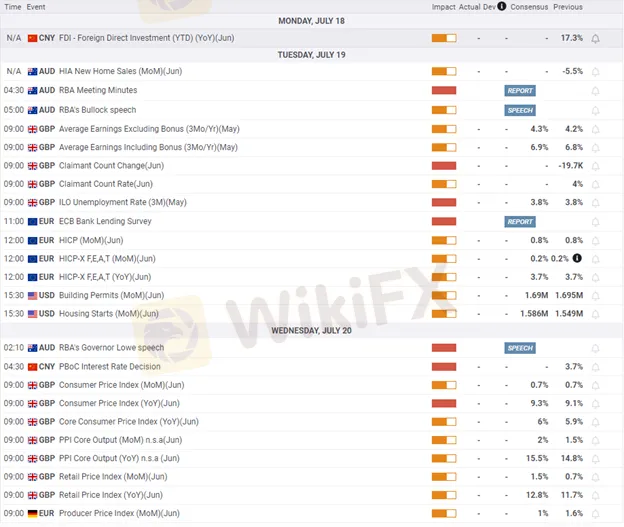简体中文
繁體中文
English
Pусский
日本語
ภาษาไทย
Tiếng Việt
Bahasa Indonesia
Español
हिन्दी
Filippiiniläinen
Français
Deutsch
Português
Türkçe
한국어
العربية
GemForex - weekly analysis
Abstract:weekly analysis

During the previous week, we experienced one of the most volatile periods for the majority of Forex pairs, in the spotlight the major ones. EURUSD achieved a 1:1 parity, something not seen since 2002, USDJPY spiked towards 139.345, and GBPUSD reached a 2-year low around 1.17328, amid a strengthening dollar, the odyssey of sanctions towards Russia, and the subsequent supply shortages that peak and affect the majority of the “Western” Economic order, further driving inflation up.
USD & European indices like the NASDAQ, DOW, CAC & DAX moved sideways during the passing week amid the uncertainty of the long-term policies implied by Western central banks, who have delayed tightening monetary policy for so long, now brace for significant effects on the global economic outlook which is still getting priced into financial assets.
ECB in particular, finds itself between a rock and a hard place, as the euro's fall to parity against the dollar for the first time in two decades poses a problem for the ECB. Letting the currency fall exacerbates inflation, already well above its 2% target. A more hawkish stance to shore up the currency, or more rapid rate hikes, could hit growth. know that getting caught in that loop of trying to support your currency through central bank actions is pretty dangerous as you need to tighten too much, hurting the economy and the currency.
Germany, and Italy, some of the biggest economies in the EU, brace for a hard landing, and in Italy, as we speak, a fresh political crisis is putting more upward pressure on Italian borrowing costs, which is already extreme compared to the German counterparts.
And yet the ECB announced recently that they will unveil a new anti-fragmentation tool in response to a surge in bond yields that has hit the most indebted countries hardest. Announcing a large envelopecould boost confidence in the ECB's commitment to fighting so-called fragmentation risks, but investor disappointment could follow if the size is too small, and confidence in the ECB central planning policymakers would plummet further.
Both US and European Central Bank cut their GDP growth expectations for 2022 and 2023 to be less than 2021, something that, amid all the drastic geopolitical changes and priced-in variables in the markets, would assure the growth expectations to not be based on the current reality, as energy supplies are worryingly low for the upcoming winter for almost all European nations, therefore the industrial output expectations for the upcoming quarters have to be more realistic.
Nevertheless, this upcoming week is expected to be hot, as this week we can expect the Euro and the British inflation numbers and retail price indices, and there is still no effective and positive signal from the policymakers of the Western banks, to combat inflation and the rising month-by-month borrowing costs.
Disclaimer:
The views in this article only represent the author's personal views, and do not constitute investment advice on this platform. This platform does not guarantee the accuracy, completeness and timeliness of the information in the article, and will not be liable for any loss caused by the use of or reliance on the information in the article.
Read more

KVB Market Analysis | 15 August: Gold Prices Drop Sharply Following U.S. CPI Report and Fed Rate Cut Expectations
Spot XAU/USD dropped nearly $18, closing below $2,450, after the latest U.S. CPI report reduced hopes for a significant Fed rate cut. The CPI rose 0.2% in July, with a notable increase in rent, particularly "owner's equivalent rent," which accelerated to 0.36%, contributing to the market's disappointment.

Global Economic and Financial Highlights: July 18, 2024
Today's news covers significant developments in global markets and politics. President Biden's campaign faces challenges due to a COVID-19 diagnosis, while China's economic strategies and tech advancements remain in focus. Key updates include the impact of US semiconductor restrictions, rising tensions in global trade, and significant shifts in corporate strategies and financial markets. The news reflects the dynamic and interconnected nature of the global economy.

Special Article: Analysis of FOMC Minutes
The FOMC minutes highlighted financial strains on low-to-moderate-income households, the Fed's data-dependent approach, and the impact of geopolitical risks. Discussions included immigration's positive impact on the labor force and modest progress toward disinflation. Potential rate cuts were mentioned if the job market deteriorates significantly. This cautious outlook emphasizes balancing inflation control and economic support.

Today's analysis: XAUUSD Faces Potential Decline Amid Fed's Rate Uncertainty
Gold (XAU/USD) is predicted to decrease due to a mix of economic factors and technical indicators. Lower-than-expected US PPI and CPI data suggest potential Fed rate cuts, initially supporting gold, but a cautious Fed outlook has pulled prices back. Technically, a bearish Head-and-Shoulders pattern suggests a trend reversal, with a break below $2,279 confirming downside targets at $2,171 and $2,106. However, a rise above $2,345 could challenge this pattern and push prices back toward $2,450.
WikiFX Broker
Latest News
Japan to Take Action to Stabilize the Yen
Ringgit Remains Flat Amid Holidays, US Debt Concerns Loom
Taurex: Is it Safe to Invest?
Vietnamese Police Bust $1.2 Million Crypto Fraud Case
WikiEXPO Global Expert Interview: Loretta Joseph——Unlock the forefront of digital finance
XTB Receives Licenses to Operate in Indonesia & UAE
SEBI Bans Big "Finfluencers for Misleading Investors"
WikiFX New Year Bash: Chance to Win 70 USDT
Malaysia’s Securities Commission Enforces Ban on Bybit & Its CEO
WikiFX Review: Is HYCM still reliable in 2024?
Currency Calculator






